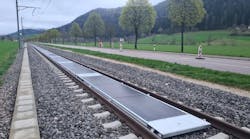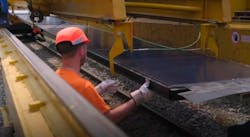Tracking Solar Energy: Swiss Project Installs PV between the Rails
We see that train a comin/Solar panels between the rails/We better get some sunshine/to energize this tale.
Apologies for taking liberties to the Johnny Cash classic, “Folsom Prison Blues,” but a new renewable energy development in Switzerland has inspired some to think differently about laying tracks. The new tune is about solar panels laid on 100 linear meters of the route in Buttes, Neuchâtel, giving a whole new meaning to e-mobility.
A company called Sun-Ways received Swiss federal approval to install 48 380-watt solar panels along the line 221 of the national rail. During the planned three-year pilot phase, Sun-Ways hopes to generate close to 16,000 kWh annually from the linear array, injecting the electric current into the local network.
It’s just the beginning, according to Sun-Ways.
“Other pilot projects are taking shape with the SNCF in France, but also in Spain, Romania and South Korea, and discussions are already underway with potential partners in China, Thailand, Australia and the United States,” according to the company’s website announcement.
This method of solar installation between railway tracks does not take any additional land such as typical solar farms, Sun-Ways noted. Some 260,000 square kilometers of space are available between railways in Europe alone, according to the company.
Renewable energy experts were calling it the first-ever solar power plant within operational train tracks. Nearly all of Switzerland’s 5,200-kilometer (3,200 miles) national rail network is electrified.
Sun-Ways spent about four years developing the technology breakthrough and gaining Swiss government and railway operator approval.
“Integrating photovoltaics into the railway sector is not easy, as the sector is highly regulated. However, a pragmatic technical development strategy based on taking into account the constraints related to railway maintenance and operation from the outset has allowed us to arrive at a technology that meets these expectations,” reads the outline on the company’s home page. “We are therefore working closely with industry players to align our technology with the most demanding infrastructure standards and safety regulations.”
Swiss track maintenance expert firm Scheuchzer SA assisted Sun-Ways in the solar installation process. The solar panels are installed in a way to make removal easy enough so as not to interrupt rail operations, according to reports.
The pilot project is tested and approved as safe for trains running as fast as 150 kilometers per hour, according to Sun-Ways.
About the Author
Rod Walton, EnergyTech Managing Editor
Managing Editor
For EnergyTech editorial inquiries, please contact Managing Editor Rod Walton at [email protected].
Rod Walton has spent 17 years covering the energy industry as a newspaper and trade journalist. He formerly was energy writer and business editor at the Tulsa World. Later, he spent six years covering the electricity power sector for Pennwell and Clarion Events. He joined Endeavor and EnergyTech in November 2021.
Walton earned his Bachelors degree in journalism from the University of Oklahoma. His career stops include the Moore American, Bartlesville Examiner-Enterprise, Wagoner Tribune and Tulsa World.
EnergyTech is focused on the mission critical and large-scale energy users and their sustainability and resiliency goals. These include the commercial and industrial sectors, as well as the military, universities, data centers and microgrids. The C&I sectors together account for close to 30 percent of greenhouse gas emissions in the U.S.
He was named Managing Editor for Microgrid Knowledge and EnergyTech starting July 1, 2023
Many large-scale energy users such as Fortune 500 companies, and mission-critical users such as military bases, universities, healthcare facilities, public safety and data centers, shifting their energy priorities to reach net-zero carbon goals within the coming decades. These include plans for renewable energy power purchase agreements, but also on-site resiliency projects such as microgrids, combined heat and power, rooftop solar, energy storage, digitalization and building efficiency upgrades.


